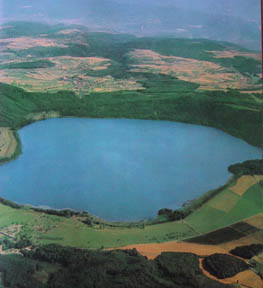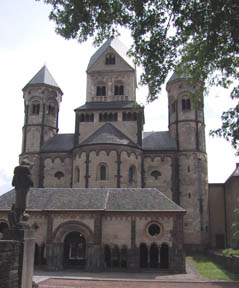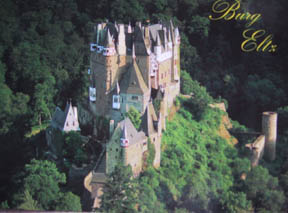 |
||
|
The Eifel is an area in western Germany, roughly bounded by the Rhine, Mosel and Meuse rivers. The area extends to Koblenz on the east, Cologne to the north, Trier to the south, and the Luxembourg and Belgium borders to the west. It is a beautiful land full of mountains, river valleys, rolling hills, quaint villages and great motorcycles roads. At the center is the Nurburgring, where we took the rider course in 1999. In June, 2000, we passed through again on our way to Amsterdam, but didn’t have the time to do any real exploring. In June, 2001, we came back to Adenau, near the Nurburgring to visit the local BMW shop as we were passing through Germany. As it would take a few days to get to the bike serviced, we had the opportunity to explore the area a little more than we had on previous occasions.
Our next stop was to Burg Eltz, a beautiful castle hidden amongst the woods. There is a road that passes by, but there is no parking, so visitors must leave their cars several kilometers back and hike the rest of the way. It appears there may be some type of s We took the tour of the castle, which was in German, but purchased the English translation so we could follow along. No pictures were allowed inside, so we couldn’t capture the interior. The castle was begun in the 1100s, then additional residences were added in the 1400s, 1500s and 1600s. The tour starts in the armory where various suits of armor and early implements of warfare, including several from the Another feature of the castle is the numerous spiral staircases, an essential part of medieval architecture. Most stairs of this type are built to rise in a clockwise fashion, thus favoring the defender, who could wield his weapon freely with his right hand, while the aggressor was hampered by the central spindle of the staircase. Most of the rooms have open beam ceilings, leaded glass windows, and a few have walls and ceilings with original 15th century murals in the Gothic style. The kitchen was built in the 1500s and has a huge hearth for an open fire, complete with a vast chimney that was used to smoke meat. There are several adjustable pot hooks over the hearth to regulate the amount of heat by raising or lowering the pot. There are large rings in the ceiling that were used to hang meat and other foods, to keep the food away from the rodents! There is a sink under the window, but it only a huge piece of flat stone, carved out to a depth of about an inch, with a drain to the outside wall. Obviously no plumbing for fresh water, either. |
||
|
If you find typographical errors or have any other problems when looking at the site please contact the Webmaster describing the problem and the page involved. |
||
|
Copyright © 2000-2009 Jim Seavey and Verna Norris All Rights Reserved |
||
 Our first stop was Maria Laach (Lake Maria), a volcanic lake formed millions of years ago. It is a peaceful, nearly round lake formed in the crater of an extinct volcano. The lake is wooded on one side and full of farmland on the other, flatter side. It is a popular day-trip for locals to take a quiet hike, rent a paddle-boat on the lake, or let the kids feed the ducks and swans. The picture at the right is from a book on The Eifel, as the aerial view shows off its features better than a picture from the land.
Our first stop was Maria Laach (Lake Maria), a volcanic lake formed millions of years ago. It is a peaceful, nearly round lake formed in the crater of an extinct volcano. The lake is wooded on one side and full of farmland on the other, flatter side. It is a popular day-trip for locals to take a quiet hike, rent a paddle-boat on the lake, or let the kids feed the ducks and swans. The picture at the right is from a book on The Eifel, as the aerial view shows off its features better than a picture from the land. Near the lake is the Benedictine Abbey of Maria Laach, first begun in 1083. The church, left, is the most beautiful monument of Norman style architecture in the Rhineland. Inside, it is equally as magnificent with its mosaic tableaus, frescoes, and simplistic vaulted ceiling. While we were there, someone was playing the organ which made the experience even more memorable.
Near the lake is the Benedictine Abbey of Maria Laach, first begun in 1083. The church, left, is the most beautiful monument of Norman style architecture in the Rhineland. Inside, it is equally as magnificent with its mosaic tableaus, frescoes, and simplistic vaulted ceiling. While we were there, someone was playing the organ which made the experience even more memorable. huttle bus from one end, but of course, that was not the direction from which we came. So we had a lovely, peaceful hike through the woods. It was about 2 1/2 kilometers (about 1 1/2 miles) to the castle from the parking lot near Moselkern, where we parked. Luckily, it is generally a gradual climb, with only a couple of steep parts. You wend your way through the thick woods, generally following the Elz river (picture at right). The path is relatively even and well maintained, so footing is not a problem. We found people of all ages making the trek up to the castle. We followed the path almost to the castle before we ever caught sight of it. It is truly hidden, although it rests on top of the hill. The picture below shows how it sits alone in the heavily wooded hills. If the picture appears postcard-perfect, it is only because it is a picture of a postcard, since we couldn’t get an appropriate view.
huttle bus from one end, but of course, that was not the direction from which we came. So we had a lovely, peaceful hike through the woods. It was about 2 1/2 kilometers (about 1 1/2 miles) to the castle from the parking lot near Moselkern, where we parked. Luckily, it is generally a gradual climb, with only a couple of steep parts. You wend your way through the thick woods, generally following the Elz river (picture at right). The path is relatively even and well maintained, so footing is not a problem. We found people of all ages making the trek up to the castle. We followed the path almost to the castle before we ever caught sight of it. It is truly hidden, although it rests on top of the hill. The picture below shows how it sits alone in the heavily wooded hills. If the picture appears postcard-perfect, it is only because it is a picture of a postcard, since we couldn’t get an appropriate view. siege of 1333. Most of the interior rooms have window-seats to take advantage of the available light and huge stone (usually slate) hearths for the fires that were needed to keep the occupants warm. The hearths were actually in the room itself, along a wall, rather than incorporated in the wall as are present day fireplaces. There are some 40 fireplaces in the castle. Many of the rooms also contain built-in toilets that empty themselves through a sewage duct and are flushed by rainwater collected off the roof.
siege of 1333. Most of the interior rooms have window-seats to take advantage of the available light and huge stone (usually slate) hearths for the fires that were needed to keep the occupants warm. The hearths were actually in the room itself, along a wall, rather than incorporated in the wall as are present day fireplaces. There are some 40 fireplaces in the castle. Many of the rooms also contain built-in toilets that empty themselves through a sewage duct and are flushed by rainwater collected off the roof.